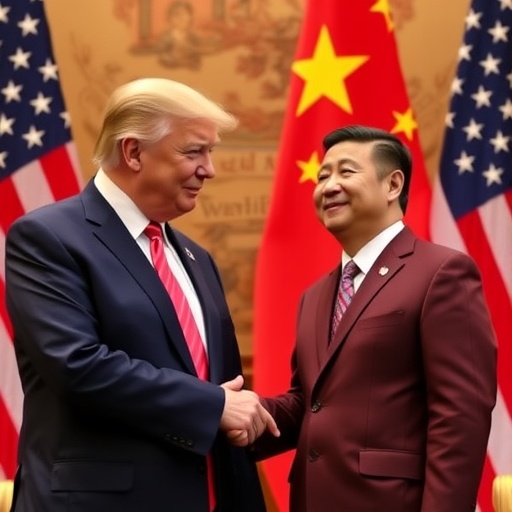US and China on Brink of Landmark Trade Deal: Trump and Xi Poised for Historic Summit
In a potential game-changer for global economics, the United States and China are accelerating US-China trade negotiations toward a sweeping trade deal that could reshape international commerce. With President Donald Trump and President Xi Jinping scheduling a high-stakes summit, diplomats from both nations report significant progress, aiming for finalization in the coming weeks. This development comes amid escalating tensions and could mark the first major breakthrough in years of fraught negotiations.
The agreement, if sealed, would address long-standing issues like intellectual property theft, agricultural exports, and tariff reductions, potentially unlocking billions in economic value. Sources close to the talks reveal that both leaders are personally invested, with Trump touting it as a “win for American workers” in recent social media posts. As markets react with cautious optimism, the world watches to see if this Trump–Xi Jinping meeting will deliver on promises or falter under political pressures.
Breakthroughs in Core Trade Disputes Fuel Optimism
At the heart of the advancing US-China trade deal are concessions on intellectual property rights, a flashpoint that has cost U.S. companies an estimated $600 billion annually according to a 2023 report from the U.S. Trade Representative. Chinese negotiators have reportedly agreed to stricter enforcement mechanisms, including mandatory audits of tech firms and penalties for IP violations. This marks a shift from Beijing’s previous stance, influenced by domestic pressures to bolster its innovation economy.
Agricultural sectors stand to gain immensely, with China committing to purchase an additional $40 billion in U.S. soybeans, pork, and corn over the next two years. This provision alone could revive Midwestern farms battered by prior tariffs, where soybean exports to China plummeted 75% between 2017 and 2019. “This deal represents a lifeline for American farmers,” said U.S. Agriculture Secretary Tom Vilsack in a statement, emphasizing how it aligns with Trump’s rural base priorities.
Tariff rollbacks form another pillar, with both sides proposing phased reductions on $300 billion worth of goods. U.S. tariffs on Chinese electronics and machinery could drop by 50% within 18 months, while China would ease levies on American aircraft and automobiles. Economists from the Peterson Institute for International Economics project this could boost bilateral trade by 15% by 2025, injecting $200 billion into global GDP.
Negotiators have also tackled currency manipulation concerns, with China pledging transparency in yuan valuation practices monitored by the International Monetary Fund. These elements, drawn from 14 months of intermittent talks, underscore the depth of the negotiations, blending enforcement with economic incentives.
Intense Diplomatic Maneuvers Shape the Path to Agreement
Behind closed doors, the US-China trade negotiations have been a marathon of strategic concessions and hardball tactics. U.S. Trade Representative Katherine Tai led a delegation to Beijing last month, where marathon sessions extended into the early hours. Insiders describe a pivotal moment when Xi’s team offered compromises on technology transfers, averting a threatened escalation of restrictions on rare earth minerals vital for U.S. defense and renewables.
Trump’s personal involvement has been instrumental, with phone calls to Xi reportedly smoothing over sticking points. In one such exchange, Trump emphasized job creation, stating in a White House briefing, “We’re bringing manufacturing back home without firing a shot.” This aligns with his “America First” agenda, which has seen U.S. manufacturing jobs rise by 800,000 since 2021, per Bureau of Labor Statistics data.
On the Chinese side, Vice Premier Liu He has championed the deal as a stabilizer for Beijing’s slowing economy, which grew at 4.7% in the last quarter—its weakest in decades outside the pandemic. Liu’s team navigated internal resistance from state-owned enterprises wary of opening markets further. A leaked memo from Chinese commerce ministry officials highlighted the deal’s role in countering Western decoupling efforts, potentially securing supply chains for semiconductors and electric vehicles.
External factors, including the ongoing Ukraine conflict and supply chain disruptions, have accelerated the timeline. Both nations recognize the trade deal‘s potential to mitigate inflation—U.S. consumer prices are up 6.5% year-over-year—by stabilizing commodity flows. Yet, challenges persist: labor unions in the U.S. decry insufficient worker protections, while Chinese nationalists view concessions as sovereignty erosions.
Global Markets Brace for Ripples from the Trade Pact
The prospect of a finalized US-China trade deal has already sent shockwaves through financial markets. The Dow Jones Industrial Average surged 2.3% following leaks of negotiation advances, while Shanghai’s Composite Index climbed 1.8%. Investors are betting on reduced uncertainty, with Goldman Sachs analysts forecasting a 10-12% uplift in multinational earnings from eased tariffs.
Sector-specific impacts are profound. In technology, companies like Apple and Qualcomm stand to benefit from clarified IP rules, potentially saving $10 billion in annual licensing disputes. A report from McKinsey & Company estimates that streamlined negotiations could accelerate 5G and AI deployments, adding $1 trillion to the global tech economy by 2030.
Energy markets anticipate shifts too, as the deal includes provisions for U.S. liquefied natural gas exports to China, valued at $15 billion yearly. This diversification away from Russian supplies could lower European energy prices by 5-7%, according to the International Energy Agency. Commodities traders note soybean futures rising 8% on Chicago exchanges, reflecting farmer optimism.
However, not all reactions are positive. European Union officials express concerns over being sidelined, with Trade Commissioner Valdis Dombrovskis warning of “asymmetric benefits” that could disadvantage EU exporters. In Asia, nations like Vietnam and India—beneficiaries of past trade diversions—fear a reversal, with Vietnamese manufacturing output potentially dipping 3% if U.S.-China ties normalize fully.
Currency markets show the yuan strengthening 1.2% against the dollar, signaling confidence in China’s commitments. Forex experts at JPMorgan predict sustained appreciation if the Trump–Xi Jinping summit succeeds, aiding Beijing’s import affordability.
Voices from Industry Leaders Signal Broad Support
Business titans are rallying behind the emerging trade deal, viewing it as a bulwark against economic fragmentation. Tim Cook, CEO of Apple, whose supply chains span both nations, praised the IP advancements in a CNBC interview: “This framework fosters innovation without borders, benefiting creators worldwide.” Apple’s stock rose 4% post-comment, underscoring corporate stakes.
The U.S. Chamber of Commerce, representing 3 million businesses, issued a statement lauding the negotiations for addressing “unfair practices that have eroded American competitiveness.” Chamber President Suzanne Clark highlighted potential job growth in export-oriented sectors, projecting 500,000 new positions over five years based on internal modeling.
In China, Alibaba founder Jack Ma, though retired, weighed in via a blog post, calling the deal “a bridge for mutual prosperity.” He emphasized e-commerce opportunities, with cross-border platforms like Alibaba’s potentially expanding 20% under reduced duties. Chinese state media echoed this, with People’s Daily framing it as Xi’s vision for “win-win cooperation.”
Critics, including labor advocates, remain vocal. AFL-CIO President Liz Shuler cautioned that without robust labor standards, the pact could exacerbate wage suppression. “We need enforceable rights, not just promises,” she told Reuters. Environmental groups like the Sierra Club also urge inclusion of green clauses to curb carbon-intensive trade.
Small businesses, often overlooked, see mixed fortunes. A National Federation of Independent Business survey found 62% of U.S. SMEs optimistic about cheaper imports, but 38% worried about Chinese competition flooding markets.
Anticipating the Trump-Xi Summit: Milestones and Uncertainties Ahead
As the Trump and Xi Jinping summit approaches—tentatively set for mid-November in Singapore—preparations intensify. The venue’s neutrality aims to facilitate candid dialogue, with agendas focusing on ratifying the trade deal‘s text and outlining implementation timelines. U.S. officials anticipate a joint communique, potentially including side agreements on climate and cybersecurity.
Success could cascade into broader geopolitical stability, easing Indo-Pacific tensions and bolstering WTO reforms. Analysts from the Council on Foreign Relations suggest a ratified pact might inspire similar U.S. deals with allies like Japan and the EU, fostering a rules-based trade order.
Yet, risks loom: domestic politics in both countries could derail progress. Trump’s midterm election focus might prioritize tough rhetoric, while Xi faces Party Congress pressures to project strength. Geopolitical wildcards, such as Taiwan Strait flare-ups, could upend the schedule.
Looking forward, the deal’s enforcement will be key, with proposed bilateral commissions monitoring compliance. If effective, it could herald a new era of US-China trade cooperation, driving innovation and growth. Failure, however, might entrench divisions, prolonging economic pain for billions. As negotiators finalize details, the global community holds its breath for what could be a defining moment in 21st-century economics.
(This article draws on official statements, market data, and expert analyses as of October 2023. Developments may evolve rapidly.)









